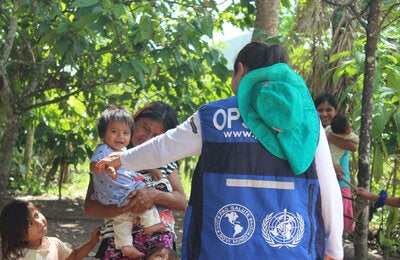
New York, 24 September 2024 (PAHO) – The Pan American Health Organization (PAHO) Director, Dr. Jarbas Barbosa, today called on partners and donors to support countries of the Americas to address the “unacceptable” number of cervical cancer cases and deaths. Almost 80,000 women in the Region are affected each year, highlighting the need for widespread implementation of HPV vaccines, HPV testing and treatment.
Speaking at the “A Global First: A Blueprint for Eliminating Cervical Cancer in the Americas” panel at the Concordia Annual Summit in New York, Dr. Barbosa highlighted that “unlike most types of cancer, the causes of cervical cancer are well-known: persistent infection with human papillomavirus (HPV).”
“Women are suffering and dying from a disease that we have the tools to prevent, treat and ultimately eliminate as a public health problem,” he added. "PAHO is committed to working with the countries of the Americas and our partners to eliminate cervical cancer from the Region for good, and in doing so become the first to eliminate a cancer of any kind".
During the panel, which included Monica Garcia Gomez, Minister of Health of Spain, Violaine Mitchell, Director of Immunization of the Bill & Melinda Gates Foundation, and Dr. Katherine Bliss, Director of Immunizations and Health Systems Resilience at the Center for Strategic and International Studies (CSIS), participants discussed the progress being made towards cervical cancer elimination and discussed ways to improve the availability of vaccines, screening and treatment technologies in the Americas.
Cervical cancer disproportionately impacts women in low-and middle-income countries: Latin America and the Caribbean have the second highest cervical cancer incidence and mortality rates globally, after Africa.
In 2020, member states of the World Health Organization (WHO) adopted the Strategy to Accelerate the Elimination of Cervical Cancer as a Public Health Problem. The strategy outlines three objectives for 2030: 90% HPV vaccination coverage in girls by the age of 15, 70% screening coverage, 90% treatment of precancerous lesions and management of 90% of invasive cancer cases (known as the 90-70-90 targets).
During his intervention, Dr. Barbosa said that while countries of the Americas have “the tools and commitment needed to end cervical cancer,” it is crucial that governments, private companies and philanthropic organizations work together to make cervical cancer elimination a reality.
Of the 51 countries and territories of the Americas, 48 have already introduced the HPV vaccine, yet coverage varies widely, from less than 10% in some countries to over 80% in others.
The PAHO Director also highlighted that while HPV testing is more accurate, cost-effective and modern compared to cervical cytology programs, fewer than ten countries have adopted it.
This is why it is crucial that “we are all engaged,” Dr. Barbosa said. “There is a role for everybody in scaling access to life-saving HPV vaccines, screening and treatment for women and girls. I invite you to be part of making history by eliminating cervical cancer in the Americas”.
PAHO continues to work with countries of the Americas towards the elimination of cervical cancer. This includes through the strengthening of national elimination plans based on HPV vaccination, HPV testing and the treatment of premalignant lesions and cancer at the primary care level. PAHO also provides countries with technical support to improve information systems to monitor and evaluate actions and progress towards cervical cancer elimination. In addition, the Organization’s pooled procurement mechanism, the PAHO Revolving Funds offers Member States safe and quality HPV vaccines, HPV tests, and ablative treatment devices at affordable prices.
Cervical cancer is one of the diseases addressed in PAHO’s Elimination Initiative, which aims to eliminate more than 30 communicable diseases and related conditions by 2030. This effort to improve the quality of life for people and communities builds on PAHO’s decades-long legacy in disease elimination, from smallpox and polio to rubella and, in many countries, malaria, HIV and more.




